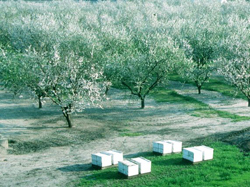Beekeeping has been carried out for thousands of years. Over this time the practice of beekeeping has developed greatly. Beekeepers learn from eachother and can consult beekeeping books, magazines, and websites to get advice on practically any topic. However, many of the things that beekeepers do are not based on scientific evidence gained through experiments designed to compare alternative methods. Rather, they are based on the accumulation of experience. In this respect, beekeeping is probably not very different from many other areas of human life. Conservation biology and medicine are just two areas in which efforts are being made to put practice on a more objective scientific basis. Would you want your doctor to prescribe a medicine or medical treatment that had not been scientifically tested, even if it had been used by generations of physicians?
 Bee hives at an almond farm in California
Bee hives at an almond farm in California
One of the common procedures carried out by beekeepers is queen introduction: a queen is taken from one colony and introduced into another. Queen introduction is needed when dividing hives, to replace a failing or poor quality queen, and sometimes in queen rearing when virgin queens are introduced into queen mating hives. The most common method used is the introduction cage. A queen is placed in a wire mesh cage that is then placed into a queenless colony. After a few days the queen is released. The success rate of this method is acceptable but is not 100 per cent. LASI research has shown that there is a much better method for introducing queens that is both quicker and gives higher acceptance rates, even 100 per cent. A queen can be directly introduced, that is without a cage, into a hive that has been queenless for several days if the receiving hive is smoked heavily. Why is this better method not more used, especially as it is mentioned in some beekeeping books? The probable reason is that beekeepers accept the losses associated with the cage method. It also seems to make sense as the cage should protect the queen and allow her to acquire colony odour before release.
In commercial queen rearing, many small bee hives known as queen mating hives are set out in an apiary. Virgin queens or queen cells are placed in these. At approximately one week of age, a young queen makes one or two mating flights and a few days later starts laying eggs. The commercial queen rearer then harvests the young mated queens for sale and repeats the process. One danger faced by young queens is 'drifting'. That is, returning to the wrong hive where she will be killed. Drifting is often considered a major cause of queen mortality and is reduced by spacing the mating hives apart. LASI research has found that drifting is, in fact, only a minor problem. If hives are kept in pairs on hive stands only two metres apart, the rate of drifting is no higher than if hive stands are five metres apart. There is a tendency for drifting to be lower when the two hives on a hive stand have entrances facing in opposite directions. Drifting never occurs on mating flights but on a queen's first orientation flight. Much of the loss of queens in commercial queen rearing attributed to drifting is probably due to the non-emergence of queen cells, damaged queens, etc.
These two examples show that even in basic areas of beekeeping that are apparently well understood, such as queen introduction and hive spacing, there is need for research.


